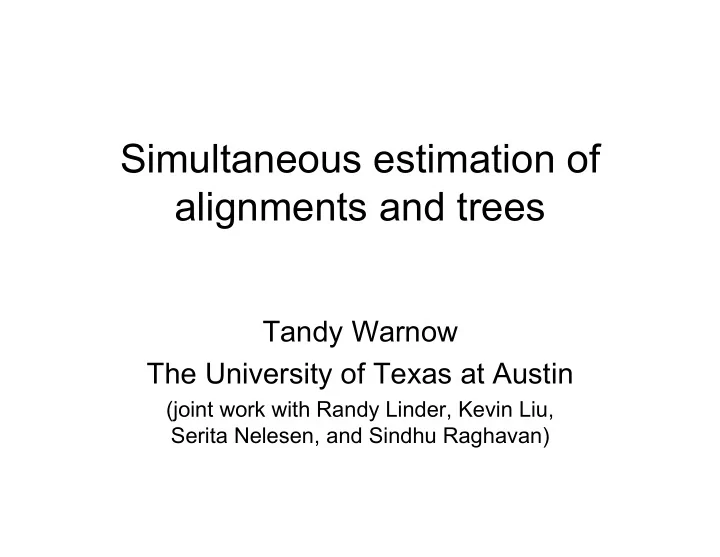

Simultaneous estimation of alignments and trees Tandy Warnow The University of Texas at Austin (joint work with Randy Linder, Kevin Liu, Serita Nelesen, and Sindhu Raghavan)
DNA Sequence Evolution -3 mil yrs AAGACTT AAGACTT -2 mil yrs AAGGCCT AAGGCCT AAGGCCT AAGGCCT TGGACTT TGGACTT TGGACTT TGGACTT -1 mil yrs AGGGCAT AGGGCAT AGGGCAT TAGCCCT TAGCCCT TAGCCCT AGCACTT AGCACTT AGCACTT today AGGGCAT TAGCCCA TAGACTT AGCACAA AGCGCTT AGGGCAT TAGCCCA TAGACTT AGCACAA AGCGCTT
FN FN: false negative (missing edge) FP: false positive (incorrect edge) FP 50% error rate
Deletion Mutation …ACGGTGCAGTTACCA… …ACCAGTCACCA… indels (insertions and deletions) also occur!
Input: unaligned sequences S1 = AGGCTATCACCTGACCTCCA S2 = TAGCTATCACGACCGC S3 = TAGCTGACCGC S4 = TCACGACCGACA
Phase 1: Multiple Sequence Alignment S1 = AGGCTATCACCTGACCTCCA S1 = -AGGCTATCACCTGACCTCCA S2 = TAGCTATCACGACCGC S2 = TAG-CTATCAC--GACCGC-- S3 = TAGCTGACCGC S3 = TAG-CT-------GACCGC-- S4 = TCACGACCGACA S4 = -------TCAC--GACCGACA
Phase 2: Construct tree S1 = AGGCTATCACCTGACCTCCA S1 = -AGGCTATCACCTGACCTCCA S2 = TAGCTATCACGACCGC S2 = TAG-CTATCAC--GACCGC-- S3 = TAGCTGACCGC S3 = TAG-CT-------GACCGC-- S4 = TCACGACCGACA S4 = -------TCAC--GACCGACA S1 S2 S3 S4
DNA sequence evolution Simulation using ROSE: 100 taxon model trees, models 1-4 have “long gaps”, and 5-8 have “short gaps”, site substitution is HKY+Gamma
Simultaneous estimation? • Statistical methods (e.g., AliFritz and BaliPhy) cannot be applied to datasets above ~20 sequences. • POY attempts to solve the NP-hard “minimum treelength” problem, and can be applied to larger datasets.
POY vs. Clustal • Ogden and Rosenberg did a simulation study showing POY 3.0 alignments (using simple gap penalties) were less accurate than Clustal alignments on over 99% of the datasets they generated. • Simple gap penalties are of the form gapcost(L)=cL for some constant c
This talk • POY vs. Clustal , and our response to Ogden and Rosenberg (to appear, IEEE Transactions on Computational Biology and Bioinformatics, Liu et al.) • SATé : our work (in progress, unpublished) on statistical co-estimation of trees and alignments.
POY’s optimization problem • Given set S of sequences (not in an alignment) and an edit distance function • Find tree T with leaves labelled by the sequences of S, and internal nodes labelled by other sequences, of minimum total edit distance. NP-hard. (Even finding the best sequences for a fixed tree is NP-hard)
Deletion Mutation The true pairwise alignment is: …ACGGTGCAGTTACCA… …ACGGTGCAGTTACCA… …AC----CAGTCACCA… …ACCAGTCACCA… The true multiple alignment on a set of homologous sequences is obtained by tracing their evolutionary history, and extending the pairwise alignments on the edges to a multiple alignment on the leaf sequences.
Alignment Error (SP) • A C A T - - - G C True alignment • C A A - G A T G C • A C A T G - - - C Est. alignment • - C A A G A T G C • 80% of the correct pairs are missing!
Alignment Error (SP) • A C A T - - - G C True alignment • C A A - G A T G C • A C A T G - - - C Est. alignment • - C A A G A T G C • Four of the five true homologies are missing! So the SP-error rate is 80%.
Gap penalty functions • Simple 1: all indels and substitutions have the same cost • Simple2: indels have cost 1, transitions cost 0.5, transversions cost 1 • Affine: gapcost(L)=2+L/2, transitions cost 0.5, transversions cost 1.
Results – Alignment Errors • PS is POY- score (used to estimate alignments on various trees)
POY4.0 competitive with ClustalW when using affine gap penalties • Points below the diagonal are for datasets on which POY4.0 is worse than ClustalW. • Points above the diagonal are for datasets on which POY4.0 is better than ClustalW.
Results – ClustalW vs. POY* POY* (our improvement to POY) is better than ClustalW on 90% of the datasets with short gaps (a), and over 50% of the datasets with long gaps (b)
Results – Affine Treelength Criterion
Summary (so far) • Optimizing treelength can produce very alignments that are better than Clustal, provided that affine gap penalties are used instead of simple (contrary to Ogden and Rosenberg). • Trees producing through optimizing treelength can be competitive with the best two-phase methods (even with Probtree and ML(MAFFT)). • However, continued improvement using such techniques seems unlikely.
Part II: SATé: (Simultaneous Alignment and Tree Estimation) • Developers: Warnow, Linder, Liu, and Nelesen. • Technique: search through tree/alignment space (align sequences on each tree by heuristically estimating ancestral sequences and compute ML trees on the resultant multiple alignments). • SATé returns the alignment/tree pair that optimizes maximum likelihood under GTR+Gamma+I. • Unpublished
Our method (SATé) vs. other methods • 100 taxon model trees, GTR+Gamma+gap, • Long gap models 1-4, short gap models 5-8
Observations, Conclusions, and Conjectures • Alignment accuracy is probably not best measured using standard criteria, at least if phylogeny estimation is the objective. • Improved two-phase methods are possible, but simultaneous estimation of alignments and trees is likely to yield better results. • Statistical co-estimation using gaps is probably essential (but we need good models!). • Scalability is important.
Acknowledgments • Collaborators: Randy Linder (Integrative Biology, UT-Austin), and students Kevin Liu, Serita Nelesen, and Sindhu Raghavan • Funding: the US National Science Foundation, the Newton Institute at Cambridge University, the Program for Evolutionary Dynamics at Harvard, and the Radcliffe Institute.
Recommend
More recommend